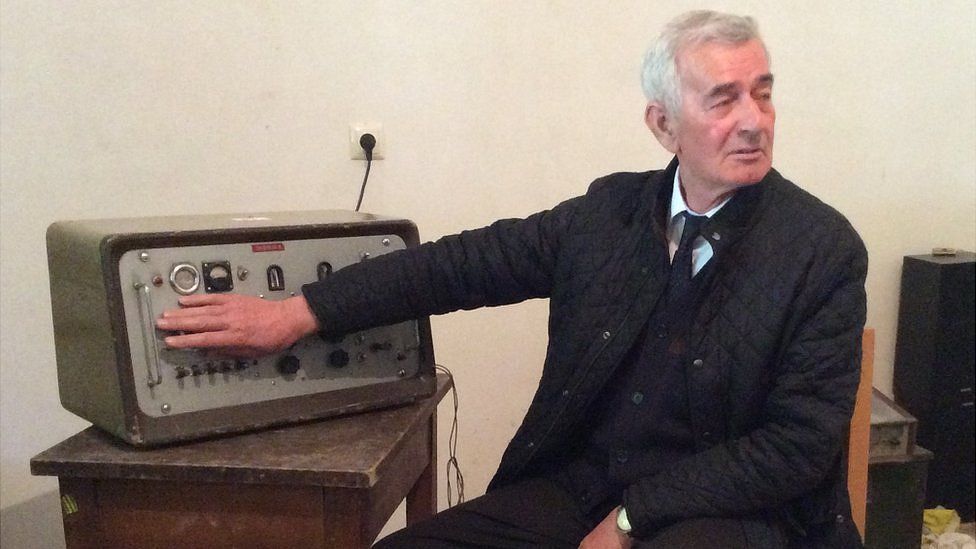Albania puts communist spy kit on show
- Published

Nesti Vako might be more than 70 years old, but he certainly doesn't look it.
Dapper and ramrod-straight, with a good head of white hair - he could have been a retired head teacher or postmaster.
In fact Nesti Vako was possibly the most important engineer under Albania's former communist dictator, Enver Hoxha. Some of his colleagues built the 750,000 or so bunkers ordered by the paranoid Hoxha.
Mr Vako was for 25 years the head of surveillance for the Sigurimi secret police, so he was very important indeed.
To many Albanians under Hoxha, the Sigurimi meant torture, execution, arbitrary imprisonment. And they knew where its agents were based - the House of Leaves, where I met Mr Vako.
Like him, the Sigurimi's old headquarters in Tirana looked nothing like what I had imagined. It's a solid red-brick house with copper drainpipes and limestone window frames. It could have been a bishop's residence. It got its name from the ivy leaves that used to cover the front.
Nesti Vako gave me a tour of the now deserted house, soon to become a museum. Some exhibits are already there: German-built recording machines, bugs in spectacle cases, broom handles and suitcases with hidden cameras.
The only things missing were the exploding cigars and a James Bond Aston Martin with pop-up machine guns.
I couldn't help liking Mr Vako despite his creepy CV. He struck me as sincere as he talked about his role protecting people from "insurgents" and "terrorists".
'Crazy system'
He bridled indignantly when I suggested that maybe it was the Sigurimi that people needed protecting from.
"The prosecutor general had to sign an order for the surveillance to take place; there was a time limit on how long you could spy on someone. There was nothing illegal," he said.
But he added that the communists made "a lot of mistakes".
"For example there was this crazy system of farm collectivisation, when people had their pigs and sheep taken away," he said. "But this was not Enver Hoxha; this was just some official attempting to advance his career."
Another ex-secret policeman, Adrian Pepaj, said: "We stopped saboteurs from blowing things up and lives being lost."
Under Hoxha the country suffered four decades of virtual isolation and it's still not visited by many outsiders.
Hoxha's Albania
1941 - Nazi Germany invades Yugoslavia and Yugoslav communists help Hoxha found Albanian Communist Party
1944 - Hoxha seizes power after communist guerrilla war against Italian and then German occupation forces
1945 - Thousands of "war criminals" prosecuted and over decades Hoxha jails or executes thousands of others
1948 - Albania cuts ties with Yugoslavia, gets economic aid from Stalin's Soviet Union and joins Warsaw Pact in 1955
1961 - Hoxha switches allegiance to communist China after Stalin's death
1978 - Hoxha cuts ties with China because of reforms there after death of Mao Zedong
1985 - Hoxha dies, replaced by Ramiz Alia
1989 - Communism collapses in Eastern Europe and in 1990 Albanians form independent political parties
Notorious prison
The dictator now suffers the dead tyrant's ultimate humiliation, becoming a tourist attraction. Like the House of Leaves, his dilapidated old house in the centre of Tirana is to become a museum. You can already visit Hoxha's personal nuclear bunker on the outskirts, a vast underground cavern.
The German ambassador to Albania, Hellmut Hoffmann, called those initiatives a good start. Germany is helping to fund the communist-era relics.
But he regretted that "none of the original sites where the terror really took place has been turned into a commemorative site".
"Probably the most notorious forced labour camp, called Spac, about two hours drive from Tirana, is rotting away," he complained.
"They have basically demolished the characteristics of a labour camp and there are no plaques - nothing at all."
Former victims "would like much more to happen here in terms of commemorating the past", he said.
Genc Bejleri from the Albanian Ministry of Culture, overseeing work at the House of Leaves, said "there were people who had an easy life under Hoxha but there were many more who really suffered".
If a father did something considered bad and was considered an enemy, then his sons and daughters would also suffer for the rest of their lives, he explained. "They would be persecuted; they would not be allowed to go to university, and that sort of thing."
Since the dark days of the dictatorship Albania has certainly taken enormous strides. Five years ago, it quietly joined Nato and is a candidate for EU membership.
The EU has built new prisons and roads here, literally paving the way for eventual membership.
But corruption in politics and the judiciary remains a legacy of the past. And as Albania strives to meet EU standards thousands of its people have already left, believing they will be better off elsewhere in Europe.
- Published6 May 2016
- Published1 May 2015
- Published28 June 2023
- Published22 November 2014